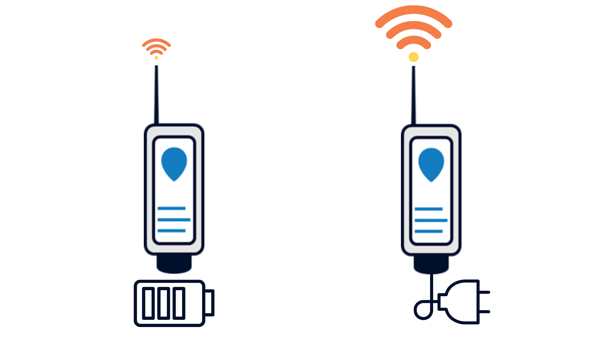
News, Insights, and more on Industrial IoT

What do you get when you combine wireless IoT and tank level monitoring?
Wireless tank level sensors! (if you were expecting a real joke...we’re sorry)
Wireless tank level sensors make collecting accurate, reliable tank data so much easier. You don’t have to worry about running cables everywhere, which brings installation costs down. And you can enrich the quality of data significantly so that you can make better business decisions.
However, you need to keep a few important things in mind when setting up wireless tank level monitors. First, you have to pick the right type of sensors. We discussed this extensively in our last blog post, so we’ll assume you’ve done your homework.
After choosing your sensors, there are four other areas to think about that are critical for the “wireless” component of wireless tank monitoring:
We touch on each of these below in more detail and explain everything you need to know about wireless tank level monitors. Armed with this knowledge, you’ll be ready to gather the tank data you need to take your operations to the next level.
There are two types of networking options for wireless tank level monitors: Wireless Local Area Networks (WLANs) and Wide Area Networks (WANs). They represent two different approaches to wireless tank monitoring, though they aren’t mutually exclusive. Let’s talk about WLANs first.
Note: For the sake of time, we’re assuming the goal is to get tank level data into a cloud computing environment for storage, visualization, and analytics. Private networks and storage are not a part of this discussion. To learn why, read this.

Some wireless tank level monitors connect to a WLAN, then use an existing WAN to connect to the internet. Other wireless tank monitors connect directly to a WAN to access the internet.
WLANs provide the benefits of wireless technology while leaving it to yo to get data onto the internet. WLANs work well for plants and facilities that already have an existing, internet-connected WLAN in place (e.g., WiFi).
In general, operators like wireless tank level monitors that operator on WLANs because they consume less power than their wide-area counterparts. This makes it more feasible to use battery-powered wireless tank monitors (more on this later). The downside of WLANs is that the burden is on you to figure out how to get your tank level data from the field to your cloud. If you’re in a remote environment without an existing WiFi network, you’ll have to add an extra hop to get that data back.
Some tank level monitors have built in network modems that connect them directly to the internet via a wide area network (WAN).Wide area networks, like cellular or satellite, are usually leased on a data-volume basis from public internet service providers (ISPs).
WANs are great because they eliminate the complexity of establishing your own internet connection for each location. Instead, your data goes straight from your tank level sensor to the cloud.
There are also low power wide area network (LPWAN) options for IoT, like LoRa, Sigfox, and NBIoT. All of these networking approaches optimize for low power and long range. To do this, they usually sacrifice on bandwidth, although not all tank level monitoring systems need much on this front.
LPWANs provide some of the pros and cons of both WLANs and WANs. They basically offer WLAN-type functionality over a much wider coverage area, but they still usually require a private gateway to connect to the internet. There aren’t many public LPWAN service providers who can manage those connections for you, especially in remote environments, so you might be on the hook for establishing that network infrastructure yourself.
One of the great benefits of wireless tank level monitors is that you can dispense running all those wires.
But, this comes with a downside. Usually, when you run wires for networking, you also run wires for power. Because of this, most wireless tank level sensors need to be able to operate on battery power.
So you need to answer two important questions:
Do you have a way to cost effectively get power to your tank monitors?
If not, will batteries provide the necessary “juice” to get the data you need?

Battery-powered wireless tank level sensors won't have as much power budget for data transmission as externally powered wireless tank monitors.
For most wireless tank level sensors, the biggest drain on power is the wireless communication. This is especially true for ARM-based processors that make sampling, storing, and processing tank data extremely power efficient.
In simple terms, wireless tank level monitors that operate on WLANs consume less power than those on WANs because the data doesn’t have to travel as far. To be clear, this doesn’t mean you can’t use WANs for battery-powered applications. But, you do have to be smart about how you do it.
For instance, WellAware’s tank level monitors have “store and forward” capabilities that enable you to take readings very often, say every 5 minutes, while only sending data wirelessly less often, perhaps daily or every few hours. You get the best of both worlds: high data frequency and low power consumption. In fact, our devices can last several years working in this way. Learn more here.
Another way to manage power consumption effectively is to use edge-based “cryouts,” where sensors only send data when triggered by some kind of alarm or escalation. For example, you could configure sensors that normally only send one reading a day to send data every five minutes during a situation where a tank overflow is imminent. That way, your sensors can “rise to the occasion,” if necessary. This takes some edge compute intelligence to accomplish, and not all wireless tank level monitors will offer this. (Hint: WellAware’s do 😊)
Ultimately, you need a wireless tank level monitor that can flex to your particular application requirements and balance power consumption with data quality.
One of the best reasons to use wireless tank level sensors is Over-the-Air (OTA) configuration. You can easily upgrade firmware and make configuration changes remotely, saving your team from having to go onsite. Of course, there are caveats.
You need to make sure that you have access to your devices if you use a WLAN. In most cases, you’ll need port-forwarding rules and firewall rules that enable those connections. If you go the WAN path, your tank level monitors will still need the security layers, but the access becomes a bit easier to manage.
 Some wireless tank level monitors have the benefit of over-the-air (OTA) configuration
Some wireless tank level monitors have the benefit of over-the-air (OTA) configuration
Be aware that some wireless tank level monitoring devices use non-TCP/IP protocols, like proprietary 900 MHz or ZigBee, for example, that add complexity to the equation. If this is true for you, you’ll need some way to convert between protocols to gain access. You’ll also likely have less control over your devices, as you may have to use potentially proprietary software to interact with your sensors.
The same can be said for some LPWANs that don’t use TCP/IP protocols. LPWANs are great for getting long wireless range and conserving power, but they are more restrictive when it comes to deploying OTA updates. For example, you could probably upgrade firmware on a 4G LTE network in seconds, whereas doing the same on an LPWAN could take hours or days.
Cellular networks are great for OTA configuration because they natively support TCP/IP packets. You can directly interface with your tank level monitoring devices as long as it has a web server or API. The same might not be true for satellite networks, so be sure to do your research if you are considering that route.
Lastly, you have to pay close attention to security. Securing your wireless tank level sensors is absolutely critical, even though it might seem trivial. Keep in mind that security is not just about safeguarding your tank level data; it’s also about protecting your business.
Wireless tank level monitoring devices, like all connected devices, create additional attack planes to your corporate networks. We’ve seen countless examples of this (here, here, and here). If hackers can get into private networks via smart thermostats and baby monitors, they can exploit your tank level sensors as well.

Strong security keeps bad actors from using your wireless tank level sensors to access your sensitive corporate networks.
Secure your devices with encryption, authentication, session management, and more. Don’t give bad actors any chance to interfere with your tank level monitors or your business more broadly. For example, WellAware uses “zero trust” principles to secure our IoT platform from end-to-end. Bottom line: Security matters. Tremendously. The consequences of bad security could extend far beyond the financial realm and even affect people’s safety.
We strongly recommend wireless tank level sensors. They are a fantastic way to improve the quality of your monitoring efforts while leveraging the cost-saving benefits of wireless connectivity.
Remember to do your homework, evaluate the risks carefully, and choose the best wireless tank monitor to accomplish your business objectives.
Connect with us today to learn more about how WellAware’s tank level monitoring system alleviates the challenges operators face when implementing IoT across liquids infrastructure.
Like what you're reading? Sign up for updates!
Have a Question?